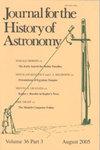Time in Pre-Columbian America
IF 0.3
3区 哲学
Q3 HISTORY & PHILOSOPHY OF SCIENCE
引用次数: 0
Abstract
Celebrated for scholarly symposia on Pre-Columbian America, the Dumbarton Oaks Research Library and Collection in Washington, D.C. mobilized a program on time in Mesoamerica and the Andes in the run-up to the 21 December 2012 completion of baktun 13, a calendrically significant interval in the Maya Long Count odometer of time. The world at that time was preoccupied with the meaning of time in the ancient Maya world, and international media routinely spotlighted the dubious claims of self-appointed purveyors of apocalypse. On the other hand, the 14 articles collected here and edited by symposium organizer Anthony F. Aveni emerged from the presentations by authentic experts in astronomy, anthropology, archaeology, art history, and history of science. Varied in focus and approach, these papers broadly belong to studies of astronomy and culture, with an emphasis on time, the calendar, and time-factored enterprises. According to the dust wrapper, the collection addresses how history was conceived, codified, and preserved in ancient Mesoamerica and the Andes, how enterprises—particularly rituals—were timed and why, and what we can know about the indigenous perceptions and applications of time from what these societies left behind. The book’s title suggests a broad and comprehensive review—a publication that consolidates the basics, demonstrates their operation across a variety of circumstances, shows how they generate shared and divergent responses, and explains why this is so and what it means. In fact, most of the articles are very technical, highly specialized, and directed to a limited and informed audience. The material is detailed, dense, and demanding. The book opens with Aveni’s accessible and inviting introduction, and once past Richard Landes’s worthy and concept-heavy examination of end times, ordinary times, and chronological precision in the West, the greater part of the book is divided in two. One section is said to examine how time was sensed in Pre-Columbian America, and the other is assigned to the way time was registered in its communities. That distinction is, however, labored and seems designed to ease the reader’s burden with an illusion of structure. The partition doesn’t really tell the reader what is most important about the contributions each section harbors. 1048989 JHA0010.1177/00218286211048989Journal for the History of AstronomyBook Reviews book-review2021前哥伦布时代的美洲
华盛顿特区的敦巴顿橡树研究图书馆和收藏馆因举办关于前柱状美洲的学术研讨会而闻名,在2012年12月21日完成baktun 13之前,在中美洲和安第斯山脉启动了一项按时计划,这是玛雅长计数时间计中一个日历上重要的时间间隔。当时的世界专注于古代玛雅世界中时间的意义,国际媒体经常关注自封的启示录提供者的可疑说法。另一方面,由研讨会组织者Anthony F.Aveni编辑的14篇文章来自天文学、人类学、考古学、艺术史和科学史领域的权威专家的介绍。这些论文的重点和方法各不相同,广泛属于天文学和文化研究,重点是时间、日历和时间因素企业。根据防尘套的说法,这些藏品讲述了历史是如何在古代中美洲和安第斯山脉被构思、编纂和保存的,企业——尤其是仪式——是如何计时的,以及为什么,以及我们可以从这些社会留下的东西中了解到土著人对时间的看法和应用。这本书的标题提出了一个广泛而全面的综述——一本巩固了基础知识的出版物,展示了它们在各种情况下的运作,展示了如何产生共同和不同的反应,并解释了为什么会这样以及它意味着什么。事实上,大多数文章都是非常技术性的、高度专业化的,面向的是有限的、知情的受众。材料细致、致密、要求高。这本书以阿韦尼通俗易懂、引人入胜的介绍开场,在理查德·兰德斯对西方的末世、普通时代和时间精确性进行了有价值的、概念性的深入研究之后,这本书的大部分内容被一分为二。据说,其中一部分是研究前哥伦布时代的美国是如何感知时间的,另一部分是关于时间在其社区中的登记方式。然而,这种区分是费力的,似乎是为了减轻读者对结构的错觉。分区并没有真正告诉读者每个部分的贡献最重要的是什么。1048989 JHA0010.1177/02182826211048989天文学史杂志书评2021
本文章由计算机程序翻译,如有差异,请以英文原文为准。
求助全文
约1分钟内获得全文
求助全文
来源期刊

Journal for the History of Astronomy
地学天文-科学史与科学哲学
CiteScore
0.50
自引率
25.00%
发文量
44
审稿时长
>12 weeks
期刊介绍:
Science History Publications Ltd is an academic publishing company established in 1971 and based in Cambridge, England. We specialize in journals in history of science and in particular history of astronomy.
 求助内容:
求助内容: 应助结果提醒方式:
应助结果提醒方式:


